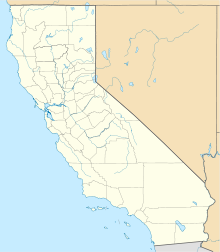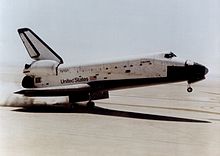Neil A. Armstrong Flight Research Center
Coordinates: 34 ° 57 '2 " N , 117 ° 53' 12" W.
The Armstrong Flight Research Center (formerly. Dryden Flight Research Center ) is an institution of NASA in the Mojave Desert on the site of Edwards Air Force Base , near Lancaster ( California ). Technological innovations in aircraft construction are tested and developed here.
The first five NACA engineers, led by Walt Williams, arrived on September 30, 1946 at Muroc Army Airfield, now Edwards Air Force Base, to prepare for supersonic test flights as part of the cooperation between the US Air Force and the NACA .
The NACA station was named High-Speed Flight Research Station (HSFRS) on November 14, 1949. This is the actual day the DFRC was founded. In mid-1954 the name was shortened to High-Speed Flight Station (HSFS). After the transition from NACA to NASA , which was founded in 1958 , the center was renamed NASA Flight Research Center on September 27, 1959 . At that time, 340 people were employed there. The final renaming to Dryden Flight Research Center in honor of longtime NACA director Hugh L. Dryden took place on March 26, 1976. At that time, 560 people were employed there. On January 16, 2014, US President Barack Obama signed the law renaming the research center the Neil A. Armstrong Flight Research Center in honor of astronaut Neil A. Armstrong , which was enforced on March 1, 2014. Armstrong was a test pilot here from 1955 to 1962. The western part of the test area ( Western Aeronautical Test Range ) was named NASA Hugh L. Dryden Aeronautical Test Range in this context .
Other NASA research centers include the Ames Research Center , the Glenn Research Center and the Langley Research Center .
Milestones
- The test pilot Chalmers Goodlin completed the first rocket-powered test flight with the Bell X-1 on December 9, 1946 . On August 20, 1947, the D-558-I Skystreak ( Douglas Aircraft Company ) set the first world speed record of 1,030.87 km / h. The first supersonic flight was carried out by Chuck Yeager with a Bell XS-1 on October 14, 1947.
- Scott Crossfield was able to reach twice the speed of sound on November 20, 1953 with a rocket-propelled D-558-II Skyrocket .
- At the beginning of 1962, test flights for the paraglider landing program of the Gemini program began . After various setbacks, several complete landings were made in the final phase of the program. At this point, however, NASA had already decided on water landings at Gemini.
- The Lunar Landing Research Vehicle (LLRV), known by the nickname “The Flying Bed Frame”, was also tested here in order to prepare the astronauts of the Apollo program for the moon landing . Test pilot Joe Walker flew the landing gear for the first time on October 30, 1964.
- On the 65th anniversary of the Wright brothers' flight , December 17, 1968, Fitz Fulton and Ted Sturmthal reached Mach 2.53 on their last flight with the XB-70 . Precise data was collected on the sonic boom and flight dynamics of a large supersonic aircraft.
- The successful sliding and landing tests of the experimental shuttle Enterprise , which were carried out from January to October 1977, were important milestones on the way to the successful use of NASA's space shuttles . When the space shuttle Columbia landed on April 14, 1981 after its successful maiden flight ( STS-1 ) on the grounds of Edwards Air Force Base, 320,000 people watched from there. The DFRC had 20,000 invited viewers. Around 300,000 people watched from the freely accessible east side. The largest public crowd, however, was present at the fourth shuttle landing on July 4, 1982, when nearly 500,000 people watched. There were another 45,000 guests on the DFRC site, including the then US President Ronald Reagan .
- The spectacular video of a controlled crash of a remote-controlled Boeing 720 demonstrating a new non-flammable fuel additive was filmed on December 1, 1984. It caused a worldwide sensation because, despite the predictions, the machine went up in flames.
- The Pegasus carrier system was first launched on April 5, 1990 from a B-52 and brought a commercial payload into a 515 kilometer high earth orbit .
- The last scheduled shuttle landing at the DFRC took place on November 1, 1993, when the Columbia touched down on the runway of the salt lake in front of 35,000 spectators and an additional 5,000 invited guests at the end of the STS-58 mission .
- The DFRC's Pathfinder solar aircraft set several new world altitude records for solar powered aircraft in the 1990s. The successor Helios set a new benchmark in 2001 with a height of 29,524 meters.
- The Boeing X-43A , an unmanned supersonic research model with a so-called scramjet drive, flew a new world record on November 16, 2004 at a speed of Mach 9.8.
See also
Web links
- AFRC homepage (English)
- On the Frontier - Flight Research at Dryden, 1946-1981 PDF, nasa.gov
literature
- Richard P. Hallion, et al .: On the Frontier: Experimental Flight at NASA Dryden. Smithsonian, Washington DC 2010, ISBN 978-1-58834-289-8 .
Individual evidence
- ↑ NASA ceremony celebrates flight research center's renaming for Neil Armstrong. collectSPACE, May 13, 2014, accessed on May 14, 2014 .
- ↑ James R. Hansen: First man. The life of Neil Armstrong , New York 2012 p. 130 ff.
- ↑ Public Law 113-75. US Government Printing Office, January 16, 2014, accessed May 14, 2014 .






